Lichens
Among the hardiest and most resistant of all plant organisms are the lichens (LI-kens). These primitive plants can stand long periods of drought, incredible heat, and freezing temperatures, making it possible for them to live where nothing else can.
These plants, with no stems, roots, or leaves, are actually a combination at least two different organisms; an alga (a plant) and a fungus. The alga manufactures the food for the partnership, while the fungus, which has no chlorophyll and cannot manufacture its own food, traps the moisture and anchors the plant to a rock, tree, or the ground. Generally, lichens are classified into three basic groups: crustose (crusty or flaky), foliose (papery or leafy), and fruticose (stalked or branching).
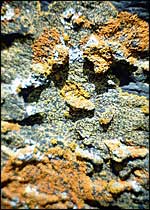
Rock surfaces appear to be splashed with paint when the colorful orange star lichen or the green stud lichen cover them.
Since some lichens appear to grow out of solid rock, primitive man believed that the rocks produced them. This idea was still accepted by many people until 1866, when a scientist with the aid of a microscope proved it incorrect. He discovered that the fungus part of the plant anchors the lichen to the rough surface of a bare rock with tiny threadlike growths.
Rock-growing lichens play an important role in nature's plan by converting rocks into soil. They produce a weak acid which slowly dissolves the minerals, forming tiny cracks in the surface of the rock. As the tiny cracks appear, the threads of the fungus dig deeper into the rock. These threads shrink in dry weather and swell in wet weather, enlarging the cracks. During cold weather, the moisture in these cracks freezes, often breaking or splitting off pieces of the rock.
This disintegrating process does not happen overnight. In fact, little progress is noticeable even after a century. But as time passes, the lichens slowly etch their way deeper into the rock, forming a hollow. Dead lichens and rock particles slowly accumulate in this hollow until there is enough soil to support mosses. More time passes; the rock-eroding process continues, and the mosses grow, die, and add themselves to the building soil. The mosses in turn give way to ferns, flowers, grasses, and bushes until one day, perhaps thousands of years later, trees grow where once there were only bare rocks. All the steps in the building of this environment are a result of the pioneering action of the lichens.
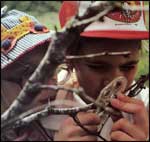
Scientists have tried to "create" lichens in the laboratory by growing the alga and fungus separately and then putting them together, but this has proven very difficult. Once the threads of the fungus grow around the alga, a few plants become lichens and can exist with no additional help from the scientists.
Lichens outside the laboratory reproduce themselves in three different ways:
- The fungus part of the plant produces spores which, under the right conditions, will grow into other fungi. However, since the fungus cannot manufacture its own food, it will die of starvation if it doesn't start growing next to an alga.
- Lichens product thousands of tiny, round buds s fine as powder. Each bud is a complete lichen package containing an alga wrapped in fungus threads. These buds are spread by the wind and will grow into new lichen plants wherever they land.
- New lichen plants also will grow from pieces broken from another lichen.
In addition to their soil building activities, lichens serve man in many other ways. Since ancient times, the plant has been used to make dyes, and it is still used for this purpose. Until only a few years ago, yarns for the famous Harris Tweeds of Scotland were dipped in lichen dyes to obtain their color.
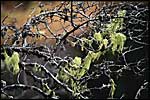
Lichens vary greatly in color; shape, and size. They can be quite complex and elaborate, brightly colored, or very drab and plain. Who would suspect that the grayish white plant below and the green hairy plant here are both lichens?
Some of you may have conducted experiments in your science classes to determine whether a solution was acid, like lemon juice, or alkaline, like ammonia. To do this you probably used a strip of litmus paper treated with a lichen dye. When placed in an acid solution the lichen substance turns red, but in an alkaline solution it turns blue.
Extracts from a few lichens are important to the perfume industry. They are used to make all the different ingredients in perfume evaporate together with a pleasant odor balance. Lichens also are used to manufacture antibiotics, medicines, and ointments, as well as thickenings for puddings and a product to stiffen fabrics and papers.
Reindeer and caribou rely on lichens to provide most of their winter food, but many other types of wildlife also add lichens to their diets during the winter when other foods are scarce or not available.
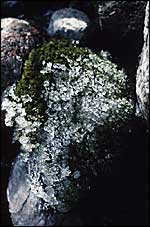
Several different kinds of lichens may be found growing together, such as blade lichen, gold eye lichen and gray star lichen.
You are probably familiar with the Bible story about how the Children of Israel were fed bread (manna) which rained down from heaven when they were starving in the wilderness after escaping from the Egyptians. Researchers believe that this manna was probably lichens. During heavy rainstorms, lichens that grow on the rocky, mountainous slopes of Northern Africa and Asia often are washed down to the barren plains below. Winds blow them about and sometimes heap them into mounts several inches deep. Since their appearance follows a rainstorm, it is easy to see how someone might think these lichens had rained down from heaven.
Ancient Egyptians gathered and dried certain lichens, ground them into a flour, and used it to make bread. Today some Arab plainsmen still use lichens in bread making; and in countries such as Lapland and Iceland where food is scarce, lichens re dried and eaten by humans today. Although nourishing, most lichens have a bitter taste. None are poisonous except for the wolf lichen (Letharia vulpina).
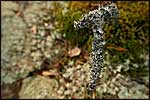
Fungi and lichens, which both grow on wood surfaces are often confused. However, as a rule, fungi grow from beneath the bark while lichens grow on the surface.
The next time you are out exploring, don't forget to look for lichens. Since there are more than two thousand kinds growing in North America, it shouldn't be too difficult for you to find some. If you happen to find lichens growing on a rock, carefully scrape a piece loose and examine the back of it. You should see tiny rock particles clinging to the plant. Now look closely t the rock. Run your fingers over the spot where the lichen was growing and you will probably be able to feel the imprint of the plant dissolved into the rock.
Lichens have been around for millions of years and, unless man destroys them with pollution, these interesting plants probably will be around for millions more.
Ilo
Hiller
1983 Lichens. Young
Naturalist. The Louise
Lindsey Merrick Texas Environment
Series, No. 6, pp. 90-93.
Texas A&M University
Press, College Station.